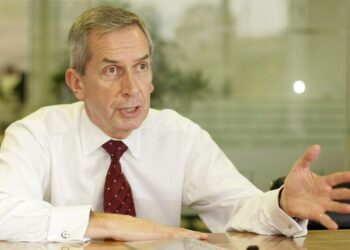US stocks recovered some of their declines since mid-August, with both of Wall Street’s major indices finishing the week higher despite hawkish remarks from Federal Reserve chair Jay Powell and a large interest rate rise in the EU.
The blue-chip S&P 500 closed 1.5 per cent higher on Friday, while the technology-heavy Nasdaq Composite jumped 2.1 per cent. That helped the two indices end three straight weeks of declines, as they added 3.7 per cent and 4.1 per cent, respectively, over the past four sessions. A FTSE gauge of worldwide equities added 2.6 per cent on Friday.
“It does appear to be a global risk-on rally amid lower rates and a weaker dollar,” analysts at JPMorgan wrote on Friday. “The market remains focused on next week’s [consumer price index] print,” they said.
US inflation data are due out on Tuesday, with economists polled by Reuters expecting a reading of 8.1 per cent year on year for August, down from 8.5 per cent in July.
Friday’s gain for Wall Street equities came a day after Fed chair Jay Powell reiterated hawkish messaging that the central bank needed to “act forthrightly” on inflation and “keep at it until the job is done”. Markets are pricing in a probable 0.75 percentage point interest rate rise for the US central bank’s next monetary policy decision in late September, which would mark the third consecutive increase of such magnitude.
As global shares rose, the euro and the British pound advanced against a softer dollar on Friday, as investors assessed how far big central banks would tighten monetary policy to curb inflation.
In currencies, the euro bounced 0.5 per cent to trade just above parity with the dollar, trimming a sharper rally earlier in the day. The common currency has weakened more than 11 per cent this year, as economic uncertainty and inflationary pressures, stoked by Russia’s invasion of Ukraine and a squeeze on gas supplies, have driven people towards the perceived safety of the dollar.
The pound gained 0.7 per cent to $1.158, having earlier this week slipped to its lowest level since 1985. Japan’s yen strengthened as much as 1.8 per cent to ¥141.49, having on Wednesday touched ¥144.98 — its weakest level against the dollar in 24 years.
Those gains were set against a softer greenback, which shed about 0.7 per cent on Friday against a basket of six peers.
Analysts at MUFG said the dollar index “has been on a steady grind higher” from a low point in August, and there was “some logic to the correction” in the past couple of days. “The ECB and the [Bank of Canada] both hiked by [0.75 percentage points] this week and it is clear that G10 central banks are now more in sync with the scale of tightening being undertaken by the Fed,” they said.
However, the analysts warned “risk appetite is unlikely to prove sustained and we see greater risks of a further tightening in financial conditions that will provide renewed support for the dollar”.
Europe’s regional Stoxx 600 gauge closed 1.5 per cent higher and Hong Kong’s Hang Seng jumped 2.7 per cent, snapping six days of losses.
Friday’s moves came a day after the European Central Bank raised interest rates by 0.75 percentage points to 0.75 per cent, having lifted borrowing costs in July for the first time in more than a decade by half a percentage point to zero. The new UK government also on Thursday announced an estimated £150bn package to shield Britain from soaring energy prices.
The ECB’s hawkish rhetoric this week led some analysts to expect another large increase at its meeting in October, with Deutsche Bank anticipating another three-quarter point rise.
German bonds sold off following the ECB decision and press conference on Thursday, with the two-year Bund yield surging to its highest level since 2011 as its price fell. Activity was steadier on Friday, with the yield broadly flat at 1.32 per cent.











